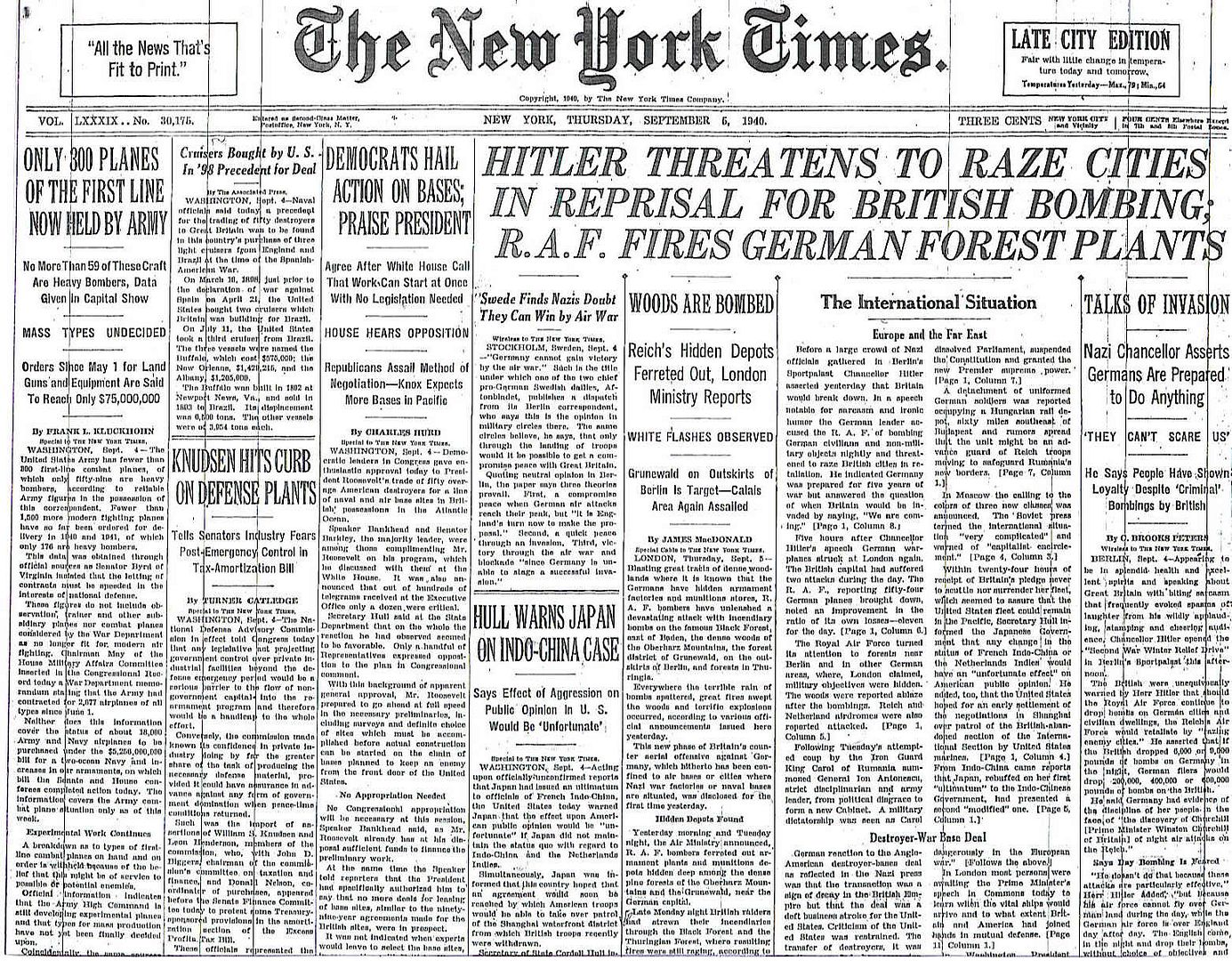
Posted on 09/05/2010 6:36:28 AM PDT by Homer_J_Simpson

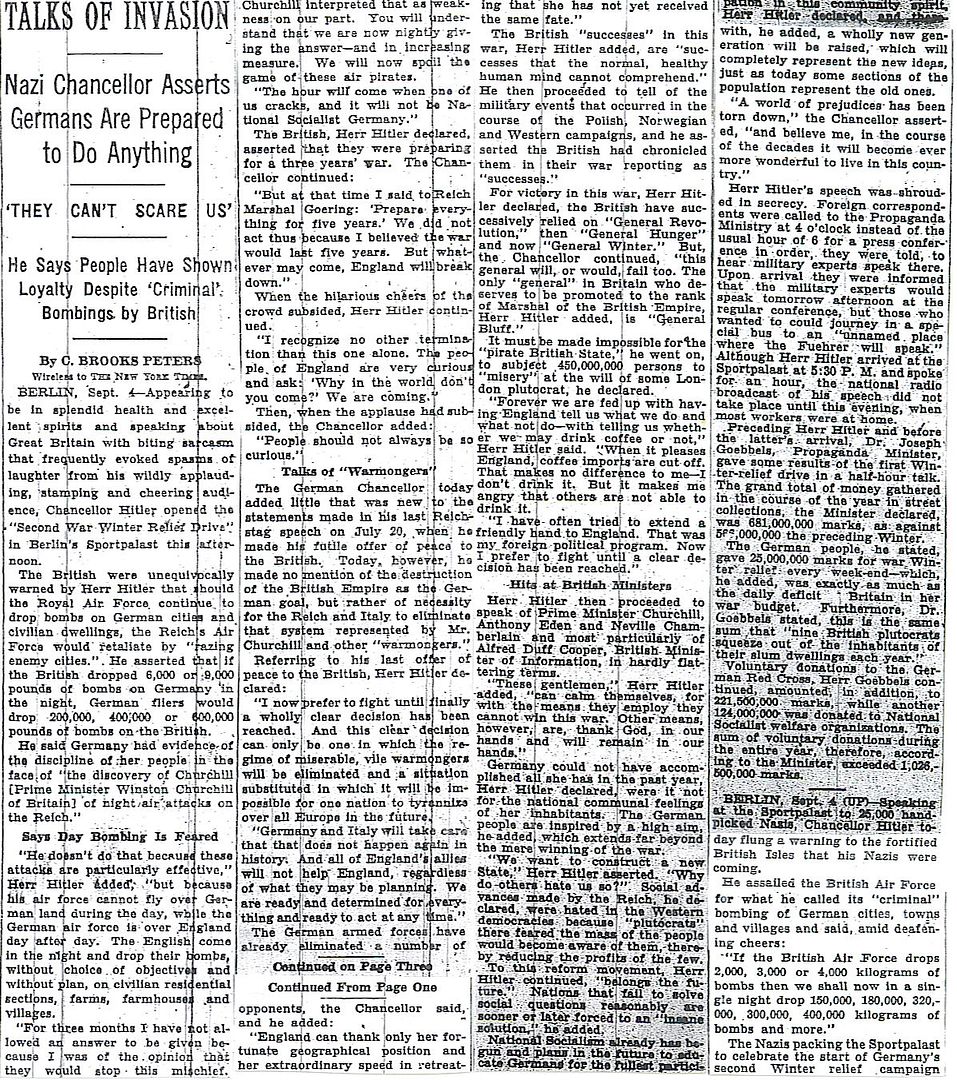
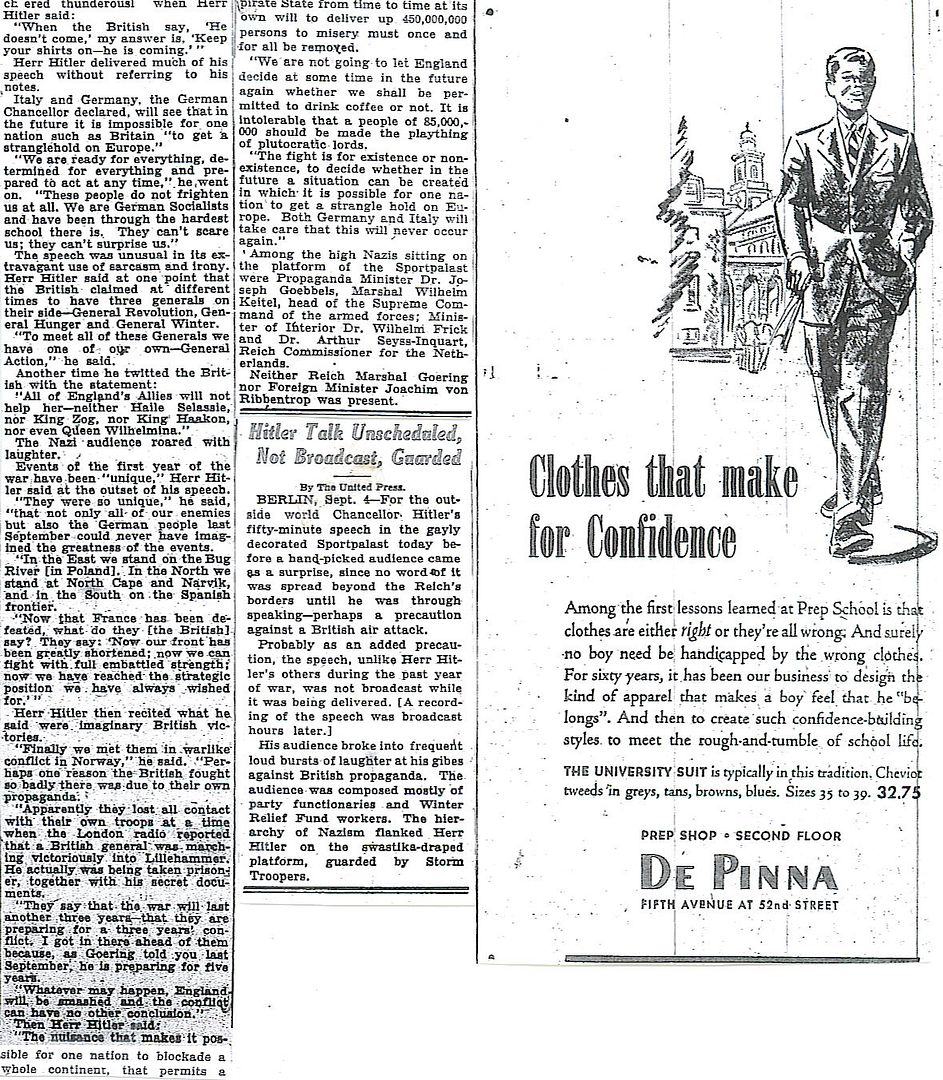
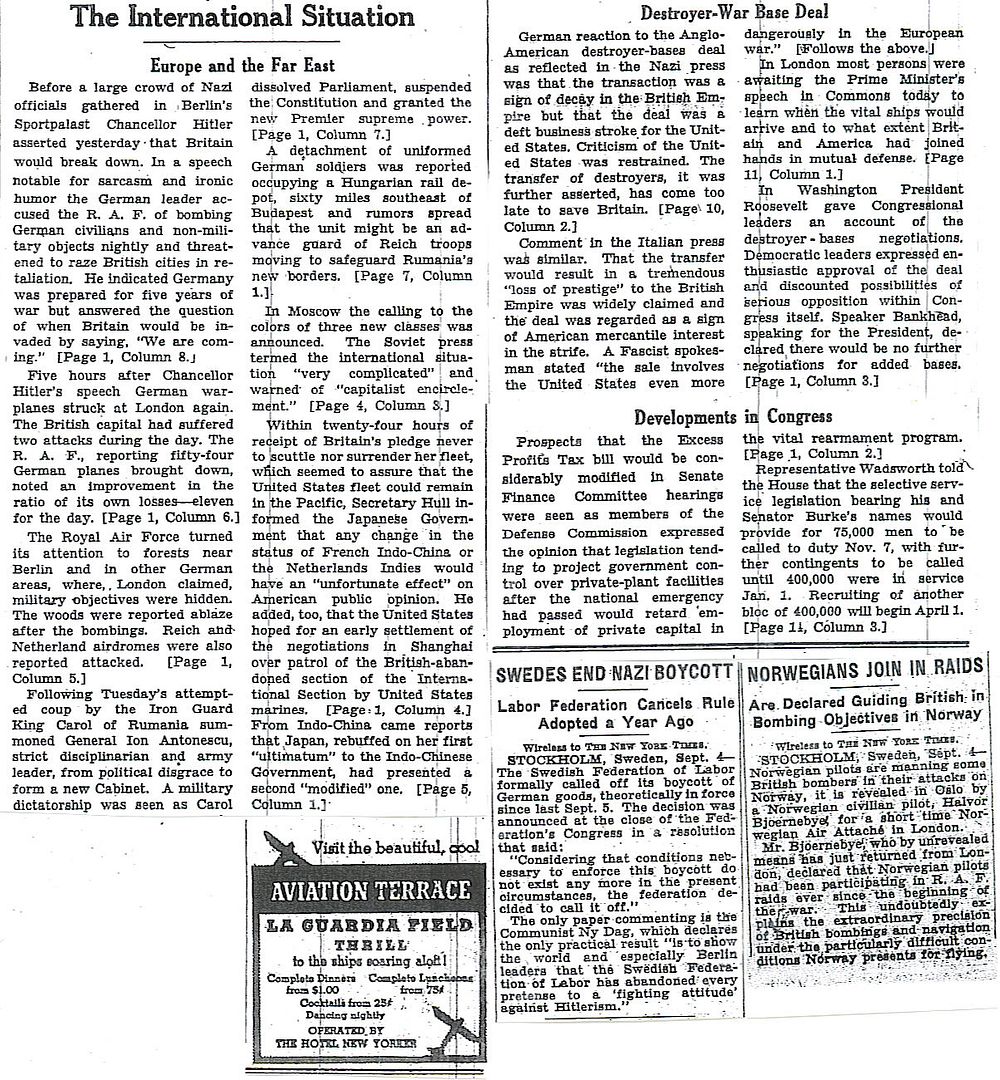
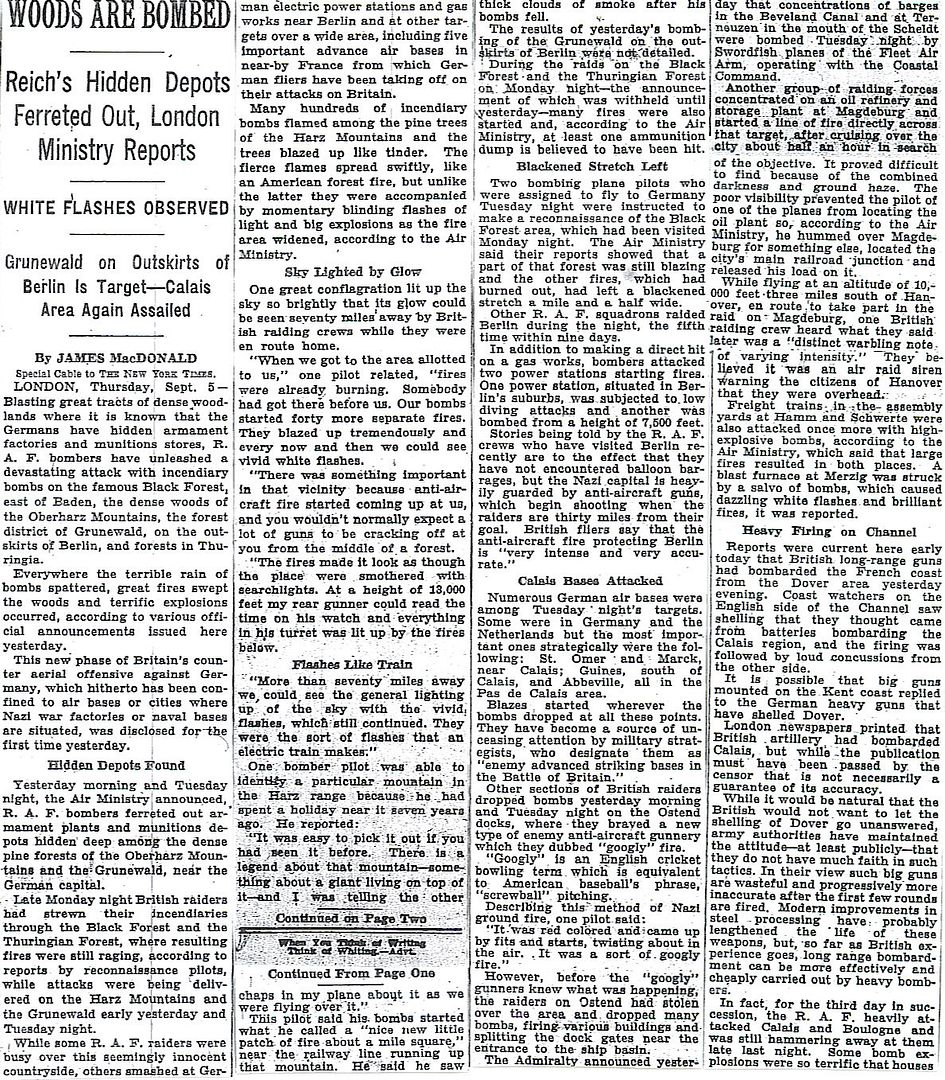
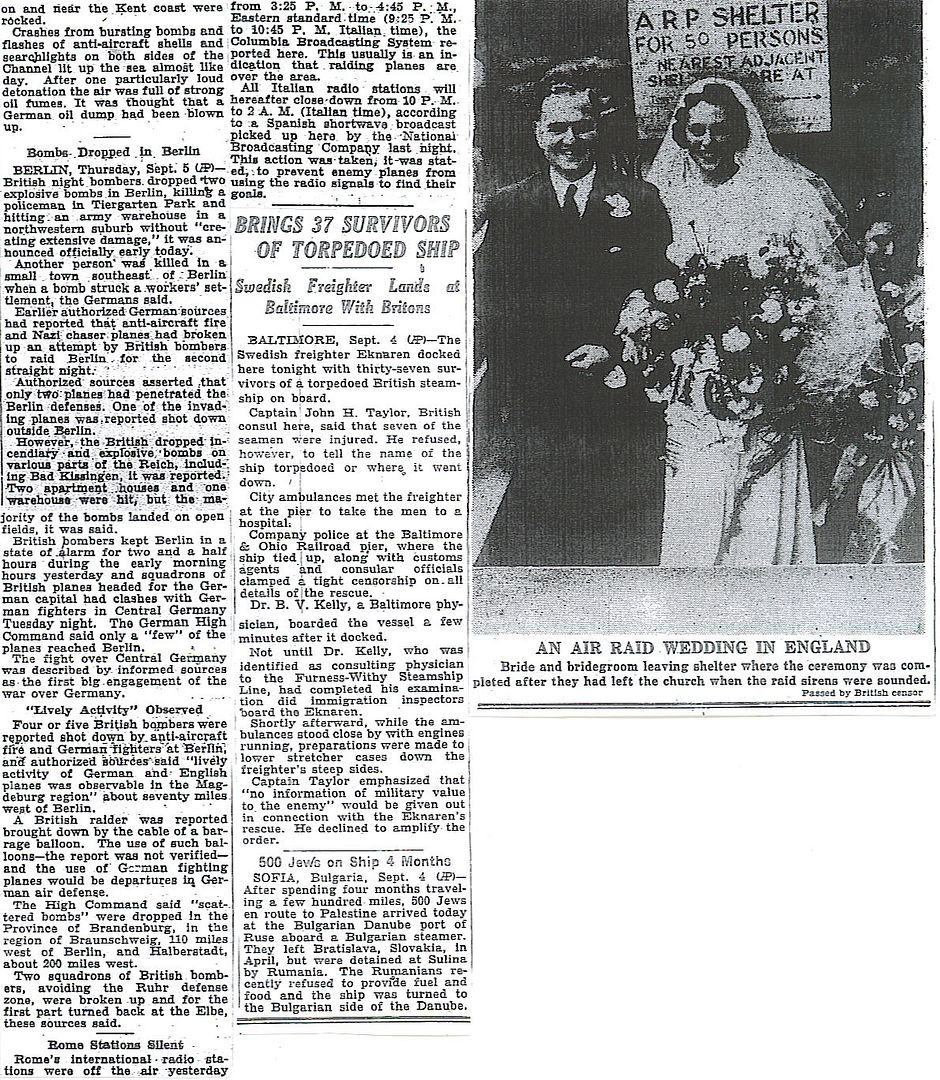
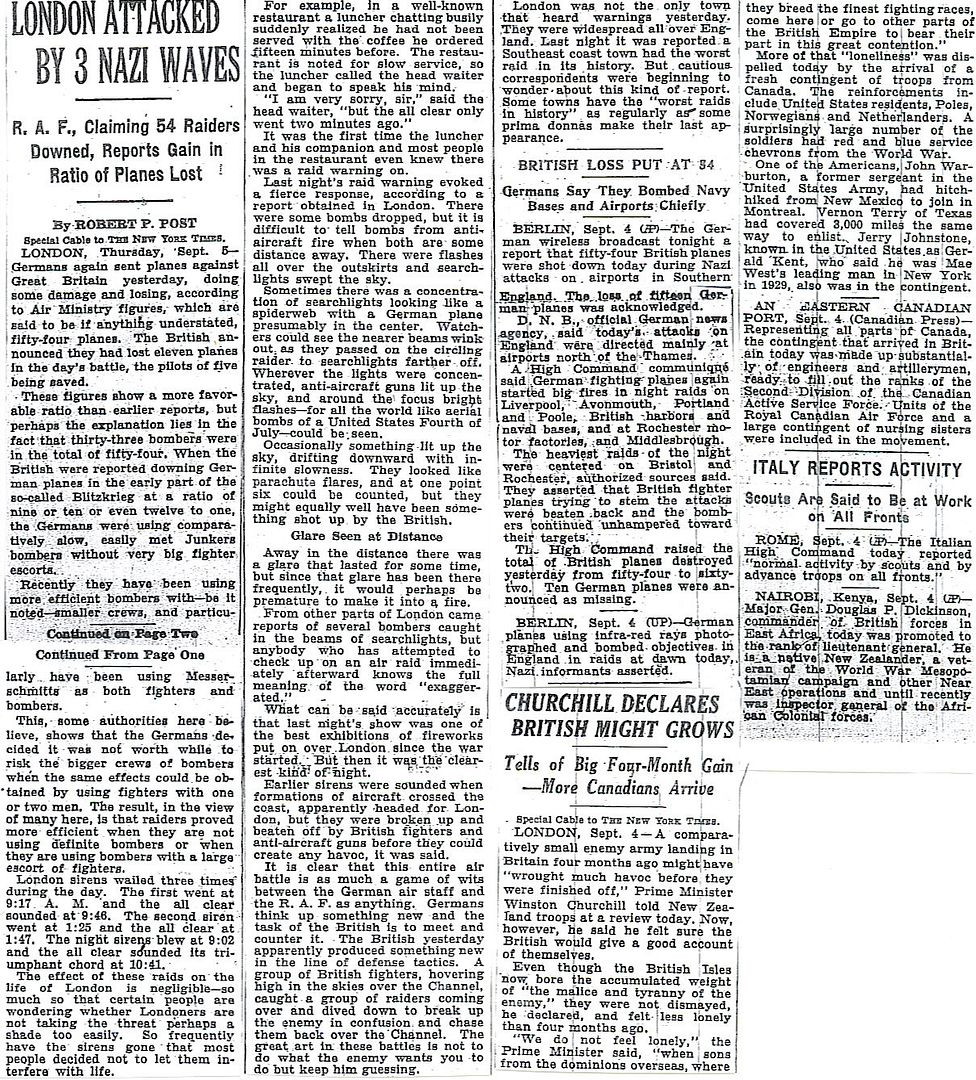
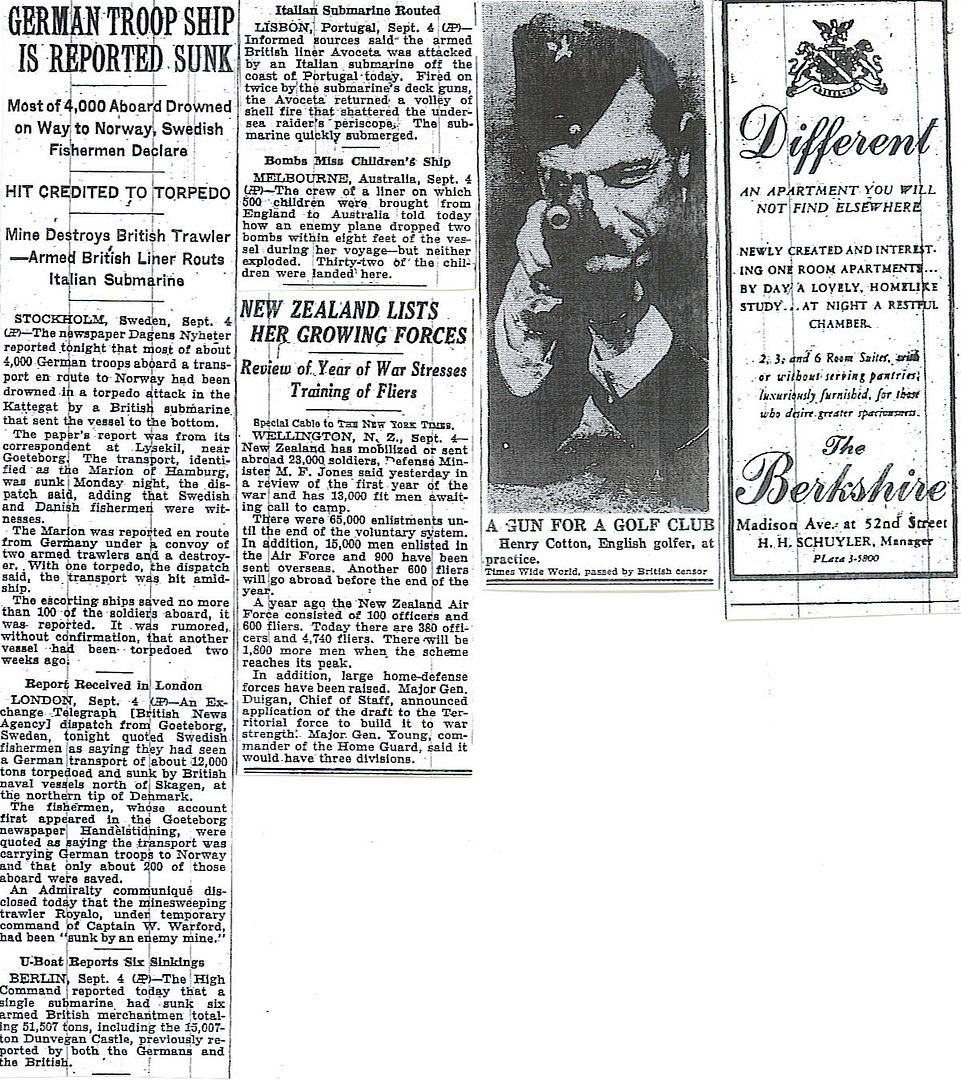
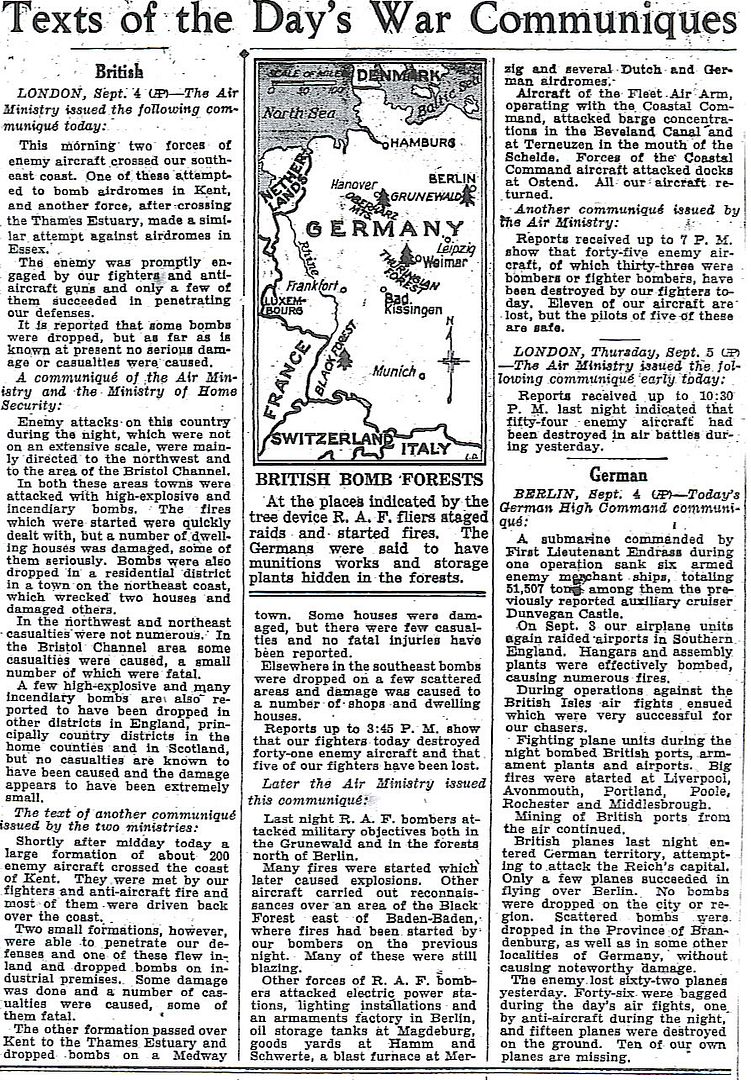
Plus a special guest map from Michael Korda’s, “With Wings Like Eagles,” showing the air defenses of England and Wales, August 1940.
The Bombing of Guernica in the Spanish Civil War, 26 April 1937
Give me ten years and you won’t recognize Germany.Adolf Hitler, 1935
Was Guernica constantly bombed like Hamburg or London? Was Guernica bombed because the factory workers(labor force) lived there or because the insurgents (? depends on who was who) were regrouping there? Spain was a rehearsal for the Germans and the Russians, as both were supplying weapons and personnel. Even our American volunteers were there. Lets not forget that Franco brought in those evil Islamic Moroccan troops too.
It is believed that the transition of German strategy from air resource denial of the British to bombing te cities led to the British victory in the Battle ogf Britain.
I heard a story that it started because 3 German bombers couldn’t find their target, so - before returning to base - just dropped their bomb loads. At the time - they didn’t know where they were - over a blacked out London.
British responded by bombing a population center - in retailiation - thinking the Germans bombed London on purpose.
The Germans/Hitler - became enraged - and changed bombing focus from British arifields and aircraft to London.
At the time - the British Field Air Marshall thought that he had 2 weeks left with the RAF before they would be beat. The change saved his aircraft.
I dig these posts.
Date: 5th September 1940

Enemy action by day
The enemy launched two attacks in the East Kent and Thames Estuary area. Activity apart from this was limited to a few reconnaissance flights mainly off the East Coast. During engagements with the enemy our fighters destroyed 36 aircraft (plus 22 probable and 17 damaged). Our casualties amounted to 23 aircraft of which 11 pilots, killed or missing.
East
One raid passed near a convoy off East Anglia and then flew inland as far as Newmarket. Later in the day and during the second attack in the South east, an aircraft reported as a four engine bomber was plotted from the Harwich area across the Estuary and out over Ramsgate. In the evening some six raids were plotted off the Coast between the Wash and the Humber.
South East
After two early reconnaissance flights in the Dungeness/Deal area, raids began to mass behind Calais. At 0935 hours these aircraft, some 70 in all, crossed the cost at Dungeness and proceeded towards Biggin Hill, returning via the Maidstone district. These aircraft were closely followed by some 50 aircraft, which flew to the Isle of Shelly and split towards Hornchurch and Harwich. At 1050 hours 12 Me109 attacked the Dover Balloons. Dover guns opened fire destroying one enemy aircraft and damaging another. Scattered raids were active inland in east Kent until about 1215 hours.
After a high reconnaissance over the North Foreland, another attack in force was made on Kent. This was opened at 1456 hours by two raids of some 112+ aircraft. Some 100 of these approached Biggin Hill but appeared to turn back short of this objective; another small split raid approached Hornchurch. A mass of plots containing elements of these raids and our fighters was tracked eastwards from the Estuary at 1530 hours. At this time another raid of 50+ aircraft was intercepted when attempting to cross the coast near Dungeness. Thereafter up to 1630 hours strong enemy formations (up to 70+) patrolled the Straits of Dover and a seaplane was reported to have rescued a German crew off Ramsgate. Nos 10 and 12 Groups assisted No 11 Group during this attack by providing patrols over Tangmere and North Weald.
South
An early reconnaissance of 3+ aircraft approached Worthing but turned back when fighters were despatched to intercept. One raid from Cherbourg flew on reconnaissance to the Bristol area and another made a reconnaissance over the Isle of Wight.
West
A "help" signal was received from a convoy off Anglesey.
By night
Enemy activity commenced soon after 2030 hours. Raids to the South Wales/Midlands/Manchester and Liverpool and West Riding areas came in between Portland and Bournemouth, and there was also activity in the South East of Scotland, and in the Tees district as far inland as Catterick. A number of raids coming from the Thames Estuary and from the South Coast, over a considerable period, remained within the London area. There were also scattered raids in Essex/Kent/Surrey and Sussex. At 0100 hours two raids were being plotted in the Irish Sea between Dublin and Belfast and between Kintyre and the Irish Coast.
By 0230 hours activity had decreased and less than a dozen raids were still being plotted inland.
Mine-laying was suspected in Lyme Bay, Thames Estuary and between Amble and St Abb's Head. Also increased activity of this nature in the Firth of Forth.

________________________________________
Statistics
Fighter Command Serviceable Aircraft as at 0900 hours, 5th September 1940
Casualties:
| Enemy Losses | ||
| By Fighters | ||
| Destroyed | Probable | Damaged |
| 30 Me109 | 12 Me109 | 6 Me109 |
| 1 Me110 | ||
| 1 He113 | ||
| 3 Do17 | ||
| 4 Do215 | 3 Do215 | |
| 4 Ju88 | 2 Ju88 | 3 Ju88 |
| 1 He111 | 3 He111 | |
| 2 Type unspecified | ||
| 36 | 22 | 17 |
| By Anti-Aircraft | ||
| Destroyed | Probable | Damaged |
| 1 E/A? type | 1 E/A? type | |
| 1 | 1 |
Patrols:
Balloons:
Aerodromes:
Attacks on Aerodromes
Organisation:
Home Security Reports
http://www.onwar.com/chrono/1940/sep40/f05sep40.htm
Germans mine Straits of Dover
Thursday, September 5, 1940 www.onwar.com
In the English Channel... German minelayers are active in the Straits of Dover during the night (September 5-6) as part of Operation Walter.
In Romania... Parliament is dissolved and the constitution suspended.
Over Britain... German aircraft attack the Biggin Hill and Detling airfields. German Ju88 and He111 bombers hit the oil storage tanks at Thameshaven (causing fires that continue to burn for several days). Maidstone is also raided during the day. Oberleutnant von Werra is captured after making a forced landing his Me109 in Kent. (He later becomes the only German prisoner to escape from Canada and return to Germany.) At night, Liverpool and Manchester are bombed.
http://homepage.ntlworld.com/andrew.etherington/month/thismonth/05.htm
September 5th, 1940
UNITED KINGDOM:
RAF Bomber Command: 4 Group (Whitley). Bombing - oil target at Regensburg - Fiat works at Turin - ‘Razzling’.
58 Sqn. Bombing - nine aircraft to Regensburg. Five bombed primary, four bombed alternatives and ‘razzling’.
77 Sqn. Six aircraft. Five got off and bombed, claiming good results.
2 Group: Blenheims of 15 and 40 Sqns raid barges in Boulogne, Calais, Dunkirk, Antwerp, Ostend and Flushing.
Battle of Britain:
RAF Fighter Command: There were two main raids on the south-east today, the first between 10:15 and 10:45 directed at targets in south-east London.
In a second and more serious phase, between 15:15 and 16:30, Detling aerodrome was bombed and five oil tanks at Thameshaven set on fire, which came to serve as a useful beacon despite the efforts of 43 and 303 Squadrons to prevent the bombing. During the engagement Flt. Lt. A. Rabagliati of 46 Sqn. took a four-cannon Hurricane, V7360, into action for the first time. Operating alongside 249 Squadron, No. 46 encountered Bf109s over the Thames Estuary, one being blown apart by cannon fire.
At night the Luftwaffe roamed almost with impunity over a wide area, many single aircraft overflying London’s IAZ (Inner Artillery Zone). Bombs falling at Greenwich.
Shops and buildings at Clifton, Bristol, were hit and four people killed, while at Liverpool bombs found the docks, Dunlop’s Walton works, domestic buildings and shops in Bootle, Lime Street and Rainhill Mental Hospital. At Prescot, St. Helens, four died, and others in incidents at Birkenhead, Wallasey and Wigan.
Losses: Luftwaffe, 23; RAF 20.
Destroyer HMS Cottesmore launched.
Minelayer HMS Manxman launched. Corvettes HMS Larkspur and Aubretia launched.
(Dave Shirlaw)
Flower class corvette HMS Picotee is completed at Harland and Wolff at Belfast. (Debbie Laws)
NORTH SEA:
4,000 German troops are believed drowned when a British submarine torpedoes the transport ship ‘Marion’. This later turns out to be a false rumour.
LUXEMBOURG: The authorities adopt Germany’s anti-Semitic Nuremburg Laws, and seize all Jewish-owned businesses.
ROMANIA:
Parliament is dissolved and the constitution is suspended.
CANADA: The 3rd Canadian Infantry Division is formed and concentrated in the Maritimes at Camp Debart, Nova Scotia and Camp Sussex, New Brunswick. (Jack McKillop)
Corvette HMCS Kenogami launched Port Arthur, Ontario. Minesweeper HMCS Malpeque launched North Vancouver, British Columbia.
(Dave Shirlaw)
U.S.A.: Corvette USS Fury launched. Destroyer USS Charles F Hughes commissioned. (Dave Shirlaw)
COSTA RICA: The government offers Cocos Island to the U.S. for the defence of the Panama Canal. (Jack McKillop)
ATLANTIC OCEAN: After months of negotiations, an agreement is announced for the transfer of 50 old but valuable US destroyers to the RN in exchange for bases in the West Indies and British Guinea. The first of them arrive in Britain towards the end of the month.
U-47 lost a man (MtrOGfr Heinrich Mantyk) overboard during use of the deck gun. (Dave Shirlaw)
http://worldwar2daybyday.blogspot.com/
Day 371 September 5, 1940
Battle of Britain Day 58. Another good day for flying. Luftwaffe sends 2 large raids across Kent. In the morning, they attack RAF airfields at Eastchurch, Lympne, North Weald and Biggin Hill. In the afternoon, targets are RAF airfields at Detling and Biggin Hill (again), Hawker aircraft works at Brooklands (slight damage and few casualties) and oil storage tanks at Thameshaven which are set ablaze. 23 German aircraft are shot down and RAF loses 20 fighters (7 pilots killed). RAF is close to breaking point due to loss of pilots and with airfields at Biggin Hill and Eastchurch out of action indefinitely and other airfields badly damaged. Furthermore, attacks on aircraft works force RAF to cover these vital factories. Overnight London, Manchester and Liverpool are bombed. RAF attacks Berlin with 85 bombers to goad Hitler into bombing of British cities instead of RAF airfields and aircraft factories.
Despite the imminent threat of invasion by Germany, Britain sends considerable materiel to defend her interests in the Middle East (Egypt, Sudan and Kenya) from Italian invasion. 6 Blenheim IV’s and 6 Hurricanes arrive in crates at the port of Takoradi in the British colony of Gold Coast, West Africa. They will be assembled and flown 3600 miles across Africa to RAF Abu Sueir, an airbase in Eastern Egypt near the Suez Canal.
German armed merchant cruiser Komet enters the Pacific Ocean via the Bering Straits, completing one of the most remarkable voyages of WWII by going through the Artic Ocean, North of USSR. http://www.bismarck-class.dk/hilfskreuzer/komet.html
300 miles Northwest of Ireland, U-47 loses Matrosenobergefreiter (Able Seaman) Heinrich Mantyk who falls overboard and drowns while using the deck gun.
Thank you.
That's about right. The excerpt at reply #4 on the 8/25 thread fills in the details.
Thanks.
I never knew till just now - the following -
My birthday is Aug 24 - the night the Germans screwed up. As a kid in the 1960’s (like 8-10) - I read everything about Battle of Britain - EVERYTHING. Hurricane is my favorite plane, etc.
\
For a student of Battle of Britain - what a date!
An interesting point to all this lays within the way you described the escalation. On the surface it seems straight forward. A few bombs on London, a retaliatory air raid on Berlin, Hitler gets angry and shifts focus to London.
But one thing we see over the last week is that there was not just a single strike on Berlin that raised Hitler’s ire. Over the last several days we have seen reports on the British hitting targets all around Berlin proper and Berlin as well. At the same time we have seen the same hits around the London area. Though there will be a dramatic shift in policy here soon, it was not a singular reaction like most accounts would leave you to believe. This has been building up and Hitler will finally decided to strike back in a major fashion.
I also have to admit that I’m a bit skeptical of the status of the R.A.F. at this point as well. Having posted the daily BoB post over the last month and a half it seems like there is always around 600 first rate fighters available. There has not been any major shift or trend in those numbers in all honesty. There are always 400+ Hurricanes and right at 200 Spitfires at the ready. The only intangible in that is the quality of the pilots.
Oh, and happy belated birthday.
The biggest mistake Hitler made.
Cougar -
If the data on readiness to which you refer are contained in the news articles - I will remind you that the British fully expected the Germans to read the News articles. It could easily be misinformation. I just tried to look up better info - but its taking too long.
They were down in aircraft, pilots, and their airfields were turning into pits.
I think the average flying life of an RAF fighter pilot was down to 87 hours.
An interesting point - I read everything back in the ‘60’s, so much of my knowledge is older - in that time period they did not stress the reasons behind the German change in strategy. They just noted that it did change. Just looking at this - I re-read some of Dowding’s notes - he describes things more than analyzes them.
Actually the data I’m using are in the Battle of Britain posts I put up each day. These numbers are actually pretty close to correct and are outside any news propaganda. Like I said though, according to the numbers there is no appreciable drop off in the number of ready aircraft. This does not necessarily equate to performance though since there are issues with not only the number of pilots, but pilot exhaustion which are intangibles that you can’t capture readily.
As far as airfields go though they managed to keep them up more than down throughout the battle. The BoB posts list the ones that are down, but a primary reason for this was really doctrine more than anything else. Planes were not spread out and well hidden and many of the grass airfields were well hidden by the air. K-sites were used to confuse Luftwaffe aviators into bombing phony airfields. Real interesting stuff but the details on the utilization of these sites are a bit fuzzy and sometimes embellished to the point of becoming almost mythical. I did a research study on Jasper Maskelyne that showed just how much exaggeration exists in the deception fields of the Second World War.
Disclaimer: Opinions posted on Free Republic are those of the individual posters and do not necessarily represent the opinion of Free Republic or its management. All materials posted herein are protected by copyright law and the exemption for fair use of copyrighted works.